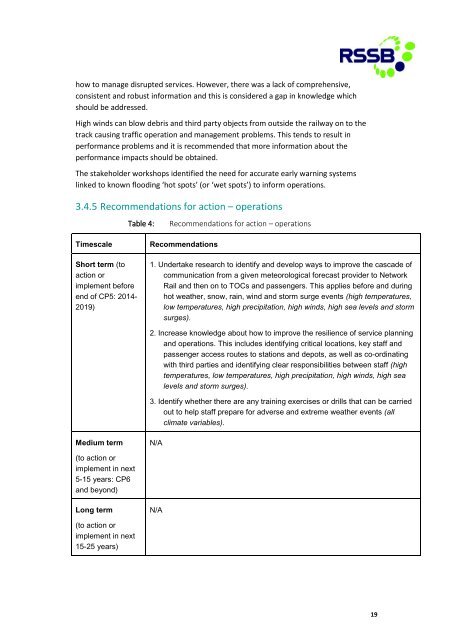Tomorrow's Railway and Climate Change Adaptation Final Report
2016-05-T1009-final-report
2016-05-T1009-final-report
Create successful ePaper yourself
Turn your PDF publications into a flip-book with our unique Google optimized e-Paper software.
how to manage disrupted services. However, there was a lack of comprehensive,<br />
consistent <strong>and</strong> robust information <strong>and</strong> this is considered a gap in knowledge which<br />
should be addressed.<br />
High winds can blow debris <strong>and</strong> third party objects from outside the railway on to the<br />
track causing traffic operation <strong>and</strong> management problems. This tends to result in<br />
performance problems <strong>and</strong> it is recommended that more information about the<br />
performance impacts should be obtained.<br />
The stakeholder workshops identified the need for accurate early warning systems<br />
linked to known flooding ‘hot spots’ (or ‘wet spots’) to inform operations.<br />
3.4.5 Recommendations for action – operations<br />
Table 4:<br />
Recommendations for action – operations<br />
Timescale<br />
Short term (to<br />
action or<br />
implement before<br />
end of CP5: 2014-<br />
2019)<br />
Recommendations<br />
1. Undertake research to identify <strong>and</strong> develop ways to improve the cascade of<br />
communication from a given meteorological forecast provider to Network<br />
Rail <strong>and</strong> then on to TOCs <strong>and</strong> passengers. This applies before <strong>and</strong> during<br />
hot weather, snow, rain, wind <strong>and</strong> storm surge events (high temperatures,<br />
low temperatures, high precipitation, high winds, high sea levels <strong>and</strong> storm<br />
surges).<br />
2. Increase knowledge about how to improve the resilience of service planning<br />
<strong>and</strong> operations. This includes identifying critical locations, key staff <strong>and</strong><br />
passenger access routes to stations <strong>and</strong> depots, as well as co-ordinating<br />
with third parties <strong>and</strong> identifying clear responsibilities between staff (high<br />
temperatures, low temperatures, high precipitation, high winds, high sea<br />
levels <strong>and</strong> storm surges).<br />
3. Identify whether there are any training exercises or drills that can be carried<br />
out to help staff prepare for adverse <strong>and</strong> extreme weather events (all<br />
climate variables).<br />
Medium term<br />
N/A<br />
(to action or<br />
implement in next<br />
5-15 years: CP6<br />
<strong>and</strong> beyond)<br />
Long term<br />
N/A<br />
(to action or<br />
implement in next<br />
15-25 years)<br />
19


